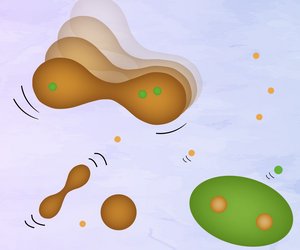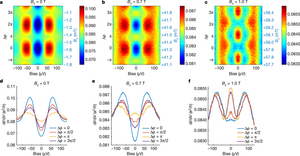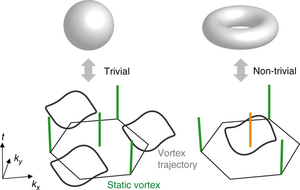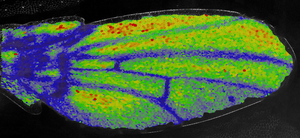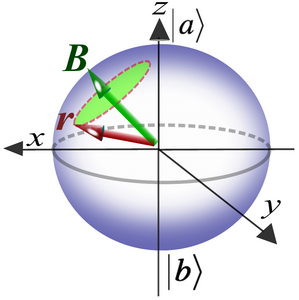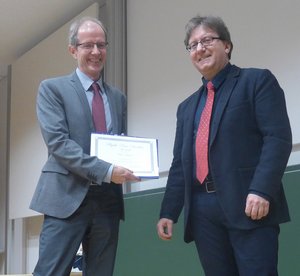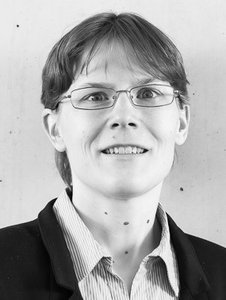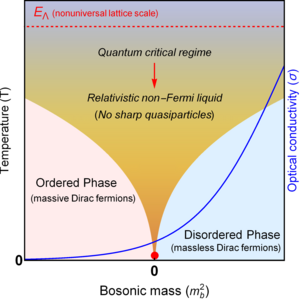
Highlights
Publication Highlights
Physics of active emulsions
Phase separating systems that are maintained away from thermodynamic equilibrium via molecular processes represent a class of active systems, which we call active emulsions. These systems are driven by external energy input, for example provided by an external fuel reservoir. The external energy input gives rise to novel phenomena that are not present in passive systems. For instance, concentration gradients can spatially organise emulsions and cause novel droplet size distributions. Another example are active droplets that are subject to chemical reactions such that their nucleation and size can be controlled, and they can divide spontaneously. In this review, we discuss the physics of phase separation and emulsions and show how the concepts that govern such phenomena can be extended to capture the physics of active emulsions. This physics is relevant to the spatial organisation of the biochemistry in living cells, for the development of novel applications in chemical engineering and models for the origin of life.
C. A. Weber et al, Rep. Prog. Phys. 82 (2019) 064601
Read moreC. A. Weber et al, Rep. Prog. Phys. 82 (2019) 064601
Publication Highlights
Topological superconductivity in a phase-controlled Josephson junction
Topological superconductors can support localized Majorana states at their boundaries. These quasi-particle excitations obey non-Abelian statistics that can be used to encode and manipulate quantum information in a topologically protected manner. Although signatures of Majorana bound states have been observed in one-dimensional systems, there is an ongoing effort to find alternative platforms that do not require fine-tuning of parameters and can be easily scaled to large numbers of states. Here, we present an experimental approach towards a two-dimensional architecture of Majorana bound states. Using a Josephson junction made of a HgTe quantum well coupled to thin-film aluminium, we are able to tune the transition between a trivial and a topological superconducting state by controlling the phase difference across the junction and applying an in-plane magnetic field. We determine the topological state of the resulting superconductor by measuring the tunnelling conductance at the edge of the junction. At low magnetic fields, we observe a minimum in the tunnelling spectra near zero bias, consistent with a trivial superconductor. However, as the magnetic field increases, the tunnelling conductance develops a zero-bias peak, which persists over a range of phase differences that expands systematically with increasing magnetic field. Our observations are consistent with theoretical predictions for this system and with full quantum mechanical numerical simulations performed on model systems with similar dimensions and parameters. Our work establishes this system as a promising platform for realizing topological superconductivity and for creating and manipulating Majorana modes and probing topological superconducting phases in two-dimensional systems.
H. Ren, F. Pientka et al, Nature 569 , 93–98 (2019)
Read moreH. Ren, F. Pientka et al, Nature
Publication Highlights
Measuring topology from dynamics by obtaining the Chern number from a linking number
Integer-valued topological indices, characterizing nonlocal properties of quantum states of matter, are known to directly predict robust physical properties of equilibrium systems. The Chern number, e.g., determines the quantized Hall conductivity of an insulator. Using non-interacting fermionic atoms in a periodically driven optical lattice, scientists from the University of Hamburg and the MPIPKS in Dresden have demonstrated experimentally that the Chern number determines also the far-from-equilibrium dynamics of a quantum system. Namely, it dictates the linking number of the trajectories of momentum-space vortices, as they emerge after an abrupt change of system parameters.
M. Tarnowski et al., Nat. Commun. 10, 1728 (2019)
Read moreM. Tarnowski et al., Nat. Commun. 10, 1728 (2019)
Publication Highlights
Quantum localization bounds Trotter errors in digital quantum simulation
Quantum computers promise to solve certain computational problems exponentially faster than any classical machine. A particularly promising application is the solution of quantum many-body problems utilizing the concept of digital quantum simulation. A fundamental challenge, however, is the control of an intrinsic error source, which appears due to the utilized time discretization. Here, we show that quantum localization-by constraining the time evolution through quantum interference-strongly bounds these errors for local observables. Digital quantum simulation is thus intrinsically much more robust than expected from known global error bounds.
M. Heyl et al., Science Advances 5, eaau8342 (2019)
Read moreM. Heyl et al., Science Advances 5, eaau8342 (2019)
Publication Highlights
How tissues respond to mechanical stress
Underlying mechanism of cell viscoelasticity revealed
Epithelial tissues like our skin are made of cells that are tightly connected through E-Cadherin – a protein that binds adjacent cells together. These tissues respond differently to forces from the environment. When they are subjected to forces for a short duration they behave like an elastic band, whereas, when subjected to the same force for a longer duration they show viscous behavior like honey. This property of tissues, called viscoelasticity, plays a key role to understand tissue shape changes during embryonic development. Although viscoelasticity is a well-known property, the molecular mechanisms underlying such viscoelastic behavior of developing tissues were largely unknown, so far.
Read moreEpithelial tissues like our skin are made of cells that are tightly connected through E-Cadherin – a protein that binds adjacent cells together. These tissues respond differently to forces from the environment. When they are subjected to forces for a short duration they behave like an elastic band, whereas, when subjected to the same force for a longer duration they show viscous behavior like honey. This property of tissues, called viscoelasticity, plays a key role to understand tissue shape changes during embryonic development. Although viscoelasticity is a well-known property, the molecular mechanisms underlying such viscoelastic behavior of developing tissues were largely unknown, so far.
Publication Highlights
Measuring the single-particle density matrix in an optical lattice
L. A. Peña Ardila et al., Phys. Rev. Lett. 121, 260401 (2018)
Ultracold atoms in optical lattices provide clean, tunable, and well-isolated realizations of paradigmatic quantum lattice models. With the recent advent of quantum-gas microscopes, they now also offer the possibility to measure the occupations of individual lattice sites. What, however, has not yet been achieved is to measure those elements of the single-particle density matrix, which are off-diagonal in the occupation basis. Here, we propose a scheme to access these basic quantities both for fermions as well as hard-core bosons and investigate its accuracy and feasibility.
Read moreUltracold atoms in optical lattices provide clean, tunable, and well-isolated realizations of paradigmatic quantum lattice models. With the recent advent of quantum-gas microscopes, they now also offer the possibility to measure the occupations of individual lattice sites. What, however, has not yet been achieved is to measure those elements of the single-particle density matrix, which are off-diagonal in the occupation basis. Here, we propose a scheme to access these basic quantities both for fermions as well as hard-core bosons and investigate its accuracy and feasibility.
Awards and Honors
Physik-Preis Dresden
Am 15. Januar 2019, 17 Uhr, wird der „Physik-Preis Dresden“ des Max-Planck-Instituts für Physik komplexer Systeme (MPI-PKS) und der TU Dresden zum dritten Mal verliehen. Der Preisträger ist der Physiker Prof. Dr. Klaus Richter. Die Preisverleihung findet am Max-Planck-Institut für Physik komplexer Systeme statt.
Prof. Dr. Klaus Richter, theoretischer Festkörperphysiker an der Universität Regensburg, erhält den diesjährigen „Physik-Preis Dresden“ für seine herausragenden theoretischen Beiträge zur semiklassischen Physik. Seine jüngeren innovativen und anspruchsvollen Ansätze zur semiklassischen Quantisierung von Vielteilchen Systemen mit Hilfe periodischer Bahnen, entwickelt zusammen mit Juan-Diego Urbina, setzen wichtige semiklassische Ergebnisse zur spektralen Statistik chaotischer Systeme fort, erzielt zusammen mit Martin Sieber zu Beginn der 2000er Jahren. Sie knüpfen auch an die wegweisende semiklassische Deutung mesoskopischer Phänomene mit Hilfe periodischer Bahnen, die Klaus Richter in der Gruppe von Nobelpreisträger Klaus v. Klitzing in Stuttgart, Mitte der 90iger Jahre, entwickelte.
Klaus Richter betreibt theoretische Physik auf hohem intellektuellen Niveau mit dem Anspruch wirklich neue Einsichten zu gewinnen. Mit seiner wissenschaftlichen Breite bietet er wertvolle Anregung sowohl für die Physiker der TU Dresden als auch des MPI-PKS.
Der „Physik-Preis Dresden“ wurde 2015 von dem Dresdner Physiker Prof. Peter Fulde, dem Gründungsdirektor des MPI-PKS gestiftet. Die Preisträger werden von einer gemeinsamen Jury der TU Dresden und des MPI-PKS bestimmt. Neben dem zentralen Kriterium der wissenschaftlichen Exzellenz ist für die Entscheidung vor allem wichtig, dass die Arbeiten der Preisträger für die Zusammenarbeit zwischen beiden Dresden-concept-Partnern MPI-PKS und TU Dresden von besonderer Bedeutung sind und deren Verbindung langfristig weiter gestärkt wurde.
Read moreProf. Dr. Klaus Richter, theoretischer Festkörperphysiker an der Universität Regensburg, erhält den diesjährigen „Physik-Preis Dresden“ für seine herausragenden theoretischen Beiträge zur semiklassischen Physik. Seine jüngeren innovativen und anspruchsvollen Ansätze zur semiklassischen Quantisierung von Vielteilchen Systemen mit Hilfe periodischer Bahnen, entwickelt zusammen mit Juan-Diego Urbina, setzen wichtige semiklassische Ergebnisse zur spektralen Statistik chaotischer Systeme fort, erzielt zusammen mit Martin Sieber zu Beginn der 2000er Jahren. Sie knüpfen auch an die wegweisende semiklassische Deutung mesoskopischer Phänomene mit Hilfe periodischer Bahnen, die Klaus Richter in der Gruppe von Nobelpreisträger Klaus v. Klitzing in Stuttgart, Mitte der 90iger Jahre, entwickelte.
Klaus Richter betreibt theoretische Physik auf hohem intellektuellen Niveau mit dem Anspruch wirklich neue Einsichten zu gewinnen. Mit seiner wissenschaftlichen Breite bietet er wertvolle Anregung sowohl für die Physiker der TU Dresden als auch des MPI-PKS.
Der „Physik-Preis Dresden“ wurde 2015 von dem Dresdner Physiker Prof. Peter Fulde, dem Gründungsdirektor des MPI-PKS gestiftet. Die Preisträger werden von einer gemeinsamen Jury der TU Dresden und des MPI-PKS bestimmt. Neben dem zentralen Kriterium der wissenschaftlichen Exzellenz ist für die Entscheidung vor allem wichtig, dass die Arbeiten der Preisträger für die Zusammenarbeit zwischen beiden Dresden-concept-Partnern MPI-PKS und TU Dresden von besonderer Bedeutung sind und deren Verbindung langfristig weiter gestärkt wurde.
Awards and Honors
Anne E. B. Nielsen receives Sapere Aude: DFF-Starting Grant
The Independent Research Fund Denmark awards Anne E. B. Nielsen a Sapere Aude starting grant of 789436 euro to carry out the project "Anyons in new settings". The purpose of the Sapere Aude initiative is to reward the most accomplished young researchers and scientists with original ideas and provide the opportunity to carry out research at the highest international level.
Read morePublication Highlights
Collisionless Transport Close to a Fermionic Quantum Critical Point in Dirac Materials
B. Roy et al., Phys. Rev. Lett. 121, 137601 (2018)
Dirac fermions are realized as low-energy excitations in a wide class of condensed matter systems, such as graphene and surface states of topological insulators. These so-called Dirac materials are rather stable against weak Hubbard-like local interactions. However, at strong interactions they may undergo quantum phase transitions into broken symmetry phases, such as spin- and charge-density-waves. The question then arises what may be the possible experimental imprints of such a quantum phase transition in terms of observable. Researcher from MPIPKS in collaboration with Nordita recently showed that the frequency-dependent electrical conductivity at both zero and finite temperature gets suppressed in the close vicinity to such critical point in comparison to its counterpart in a noninteracting system. Such peculiar, but universal behavior stems from strong interactions among wildly fluctuating gapless fermionic and bosonic order-parameter excitations inside the quantum critical regime, occupied by a relativistic non-Fermi liquid.
Read moreDirac fermions are realized as low-energy excitations in a wide class of condensed matter systems, such as graphene and surface states of topological insulators. These so-called Dirac materials are rather stable against weak Hubbard-like local interactions. However, at strong interactions they may undergo quantum phase transitions into broken symmetry phases, such as spin- and charge-density-waves. The question then arises what may be the possible experimental imprints of such a quantum phase transition in terms of observable. Researcher from MPIPKS in collaboration with Nordita recently showed that the frequency-dependent electrical conductivity at both zero and finite temperature gets suppressed in the close vicinity to such critical point in comparison to its counterpart in a noninteracting system. Such peculiar, but universal behavior stems from strong interactions among wildly fluctuating gapless fermionic and bosonic order-parameter excitations inside the quantum critical regime, occupied by a relativistic non-Fermi liquid.
Institute's News
New Clusters of Excellence for the TU Dresden - The MPIPKS is part of two new Dresden clusters
The German Research Foundation (Deutsche Forschungsgemeinschaft) announced the new Clusters of Excellence in the framework of the Excellence Strategy of the German Federal and State Governments. The TU Dresden received three new Clusters of Excellence: "Physics of Life", "Center for Tactile Internet", and "Complexity and Topology in Quantum Materials" jointly with the University of Würzburg.
The Max Planck Institute for the Physics of Complex Systems is involved in two of the new Dresden Clusters: "Physics of Life" and “Complexity and Topology in Quantum Materials".
- "Physics of Life"
- “Complexity and Topology in Quantum Materials"
Read more- "Physics of Life"
- “Complexity and Topology in Quantum Materials"

